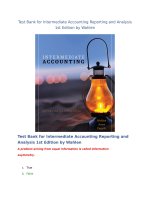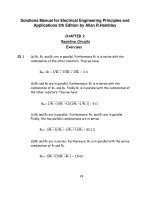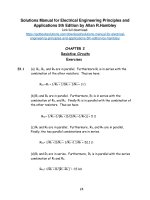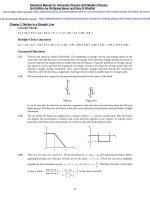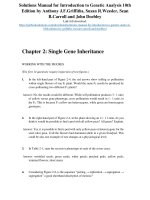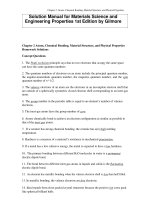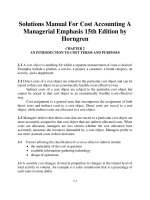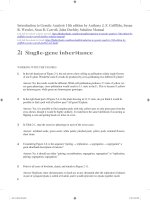Solutions manual for friendly introduction to numerical analysis 1st edition by bradie
Bạn đang xem bản rút gọn của tài liệu. Xem và tải ngay bản đầy đủ của tài liệu tại đây (113.23 KB, 13 trang )
Solutions Manual for Friendly Introduction to Numerical Analysis 1st Edition by
Brian Bradie
Link full download:
/>
Convergence
1
1.2
Convergence
Root finding.
1. Compute each of the following limits and determine the corresponding rate of
convergence.
(a)
limn→∞
(b)
limn→∞
(c)
limn→∞
(d)
n−1
n3 +2
√
√
n+1− n
sin n
n
3n2 −1
limn→∞ 7n2 +n+2
(a) For n > 1,
n
1
n−1
n−1
−0 = 3
< 3 = 2.
n3 + 2
n +2
n
n
2
Thus, nn−1
3 +2 converges to 0 with rate of convergence O(1/n ).
(b) Note that
√
√
1
(n + 1) − n
lim ( n + 1 − n) = lim √
√ = lim √
√ = 0.
n→∞
n→∞
n + 1 − n n→∞ n + 1 + n
Because
√
√
|( n + 1 − n) − 0| = √
1
1
√ < √ ,
2 n
n+1+ n
√
√
√
it follows that n + 1− n converges to 0 with rate of convergence O(1/ n).
(c) Since −1 ≤ sin n ≤ 1 for all n, it follows that
−
sin n
1
1
≤
≤
n
n
n
for all n. Then, by the squeeze theorem, limn→∞
sin n
n
= 0. Moreover, because
sin n
1
−0 ≤ ,
n
n
the rate of convergence is O(1/n).
(d) For n > 13,
1
3
4n
3n1 − 1
3n + 13
<
−
<
.
=
7n2 + n + 2 7
7(7n2 + n + 2)
49n2
10n
Therefore,
3n2 −1
7n2 +n+2
converges to
3
7
with rate of convergence O(1/n).
2
Section 1.2
2. Compute each of the following limits and determine the corresponding rate of
convergence.
(c)
ex −1
x
limx→0 sinx x
x
x−x
limx→0 e −cos
x2
(d)
limx→0
(a)
(b)
limx→0
cos x−1+x2 /2−x4 /24
x6
(a) From Taylor’s Theorem, ex = 1 + x + 12 x2 eξ for some ξ between 0 and x.
Hence,
1
ex − 1
= 1 + xeξ .
x
2
Because
ex − 1
1
− 1 = |x|eξ < |x|
x
2
for all x satisfying |x| < ln 2, it follows that
ex − 1
= 1 with rate of convergence O(x).
x→0
x
lim
3
(b) From Taylor’s Theorem, sin x = x − x6 cos ξ for some ξ between 0 and x.
Then,
sin x
x2
=1−
cos ξ
x
6
and
sin x
1
1
− 1 = |x2 cos ξ| ≤ x2 .
x
6
6
Finally,
lim
x→0
sin x
= 1 with rate of convergence O(x2 ).
x
(c) From Taylor’s Theorem, we have
1
1
ex = 1 + x + x2 + x3 eξ1
2
6
and
1
1
cos x = 1 − x2 + x3 sin ξ2
2
6
for some ξ1 and ξ2 between 0 and x. Then
x ξ1
ex − cos x − x
=1+
e − sin ξ2 .
x2
6
For sufficiently small x, eξ1 < 2, so |eξ1 − sin ξ2 | < 2 + 1 = 3. Thus,
ex − cos x − x
1
|x| ξ1
e − sin ξ2 ≤ |x|,
−1 =
x2
6
2
Convergence
and
3
ex − cos x − x
= 1 with rate of convergence O(x).
x→0
x2
lim
(d) From Taylor’s Theorem, we have
1
1 6
1
1
x + x8 cos ξ
cos x = 1 − x2 + x4 −
2
24
720
8!
for some ξ between 0 and x. Hence,
cos x − 1 + 21 x2 −
x6
and
cos x − 1 + 12 x2 −
x6
1 4
24 x
1 4
24 x
+
=−
1
1
+ x2 cos ξ,
720 8!
1
1
1
= |x2 cos ξ| ≤ |x2 |.
720
8!
8!
It therefore follows that
cos x − 1 + 21 x2 −
x→0
x6
lim
1 4
24 x
=−
1
720
with rate of convergence O(x2 ).
3. Numerically determine which of the following sequences approaches 1 faster, and
then confirm the numerical evidence by determining the rate of convergence of
each sequence.
sin x2
(sin x)2
lim
versus
lim
.
x→0 x2
x→0
x2
The values in the following table suggest that
than
(sin x)2
x2 .
x
1.000
0.100
0.010
0.001
sin x2
x2
0.84147098480790
0.99998333341667
0.99999999833333
0.99999999999983
sin x2
x2
converges toward 1 more rapidly
(sin x)2
x2
0.70807341827357
0.99667110793792
0.99996666711111
0.99999966666671
To confirm this conclusion, note that by Taylor’s Theorem,
1
sin u = u − u3 cos ξ,
6
for some ξ between 0 and u. Using the substitution u = x2 , we find
1
sin x2 = x2 − x6 cos ξ
6
4
Section 1.2
for some ξ between 0 and x2 . Consequently,
sin x2
1
1
− 1 = x4 | cos ξ| ≤ x4 .
x2
6
6
Starting from f (x) = (sin x)2 , we find
f ′ (x) = 2 sin x cos x = sin 2x, f ′′ (x) = 2 cos 2x, f ′′′ (x) = −4 sin 2x,
and f (4) (x) = −8 cos 2x. Therefore,
1
(sin x)2 = x2 − x4 cos 2ξ
3
for some ξ between 0 and x, and
1
1
(sin x)2
− 1 = x2 | cos 2ξ| ≤ x2 .
2
x
3
3
Finally,
sin x2
= 1 + O(x4 )
x2
and
(sin x)2
= 1 + O(x2 ).
x2
4. Suppose that 0 < a < b.
(a) Show that if αn = α + O(1/nb ), then αn = α + O(1/na ).
(b) Show that if f (x) = L + O(xb ), then f (x) = L + O(xa ).
(a) Suppose αn = α + O(1/nb ). Then, there exists a constant λ such that for
sufficiently large n, |αn − α| ≤ λ n1b . Because a < b, it follows that na < nb
and n1a > n1b for all n > 1. Thus,
|αn − α| ≤ λ
1
1
< λ a,
b
n
n
and αn = α + O(1/na ).
(b) Suppose f (x) = L + O(xb ). Then, there exists a constant K such that for all
sufficiently small x, |f (x) − L| ≤ K|x|b . Because a < b, it follows that for all
|x| ≤ 1, |x|b ≤ |x|a . Thus, for sufficiently small x,
|f (x) − L| ≤ K|x|b ≤ K|x|a ,
and f (x) = L + O(xa ).
5. Suppose that f1 (x) = L1 + O(xa ) and f2 (x) = L2 + O(xb ). Show that
c1 f1 (x) + c2 f2 (x) = c1 L1 + c2 L2 + O(xc ),
Convergence
5
where c = min(a, b).
Suppose f1 (x) = L1 + O(xa ) and f2 (x) = L2 + O(xb ). Then, there exist constants
K1 and K2 such that for all sufficiently small x, |f1 (x)−L1 | ≤ K1 |xa | and |f2 (x)−
L2 | ≤ K2 |xb |. Let c1 and c2 be any real numbers. Applying the triangle inequality,
we find
|c1 f1 (x) + c2 f2 (x) − (c1 L1 + c2 L2 )|
≤ |c1 ||f1 (x) − L1 | + |c2 ||f2 (x) − L2 |
≤ |c1 |K1 |xa | + |c2 |K2 |xb |.
Now, let c = min(a, b). Then, for |x| < 1,
|c1 |K1 |xa | + |c2 |K2 |xb | < |c1 |K1 |xc | + |c2 |K2 |xc | = (|c1 |K1 + |c2 |K2 )|xc |.
Consequently,
c1 f1 (x) + c2 f2 (x) = c1 L1 + c2 L2 + O(xc ).
6. The table below lists
√ the errors of successive iterates for three different methods
for approximating 3 5. Estimate the order of convergence of each method, and
explain how you arrived at your conclusions.
Method 1
4.0 ×10−2
9.1 ×10−4
4.8 ×10−7
Method 2
3.7 ×10−4
1.2 ×10−15
1.5 ×10−60
Method 3
4.3 ×10−3
1.8 ×10−8
1.4 ×10−24
If a sequence converges of order α, then the error in each term of the sequence is
roughly the error in the previous term raised to the power α. From the data for
“Method 1,” we see that each error is roughly the previous error squared; therefore,
we estimate the order of convergence to be α = 2. From the data for “Method
2,” we see that each error is roughly the previous error raised to the fourth power;
therefore, we estimate the order of convergence to be α = 4. Finally, from the data
for “Method 3,” we see that each error is roughly the previous error raised to the
third power; therefore, we estimate the order of convergence to be α = 3.
7. Let {pn } be a sequence which converges to the limit p.
(a) If
lim
n→∞
|pn+1 − p|
= 0,
|pn − p|α
what can be said about the order of convergence of {pn } to p?
(b) If
lim
n→∞
|pn+1 − p|
→ ∞,
|pn − p|α
what can be said about the order of convergence of {pn } to p?
6
Section 1.2
(a) If
|pn+1 − p|
= 0,
|pn − p|α
then the numerator approaches zero faster than the denominator. In order
to achieve a nonzero limit, we must increase the power in the denominator.
Therefore, the order of convergence must be greater than α.
(b) If
|pn+1 − p|
lim
→ ∞,
n→∞ |pn − p|α
then the denominator approaches zero faster than the numerator. In order
to achieve a nonzero limit, we must decrease the power in the denominator.
Therefore, the order of convergence must be less than α.
lim
n→∞
8. Suppose theory indicates that the sequence {pn } converges to p of order 1.5.
Explain how you would numerically verify this order of convergence.
To numerically verify the order of convergence, calculate the ratio
|pn+1 − p|
|pn − p|1.5
for several successive values of n. If the order of convergence is α = 1.5, these
ratios should approach a constant, specifically the asymptotic error constant.
√
9. Theory indicates that the following sequence should converge to 3 of order
1.618. Does the sequence actually achieve an order of convergence of 1.618? If
not, what is the actual order?
n
0
1
2
3
4
5
pn
2.000000000000000
1.666666666666667
1.727272727272727
1.732142857142857
1.732050680431722
1.732050807565499
Because the values in the third column of the following table appear to be approaching a constant,
the evidence suggests that the sequence does, in fact, converge
√
toward 3 with order of convergence α = 1.618.
√
√
n
pn
|pn − 3|/|pn−1 − 3|1.618
1 2.000000000000000
2 1.666666666666667
0.55066002953142
3 1.727272727272727
0.39429299851516
4 1.732142857142857
0.52358803162884
5 1.732050680431722
0.43100791441420
6 1.732050807565499
0.48525581579327
Convergence
7
10. Theory indicates that the following sequence should converge to 4/3 of order
1.618. Does the sequence actually achieve an order of convergence of 1.618? If
not, what is the actual order?
n
0
1
2
3
4
5
6
7
pn
1.498664098580016
1.497353997792205
1.428801977335339
1.401092915389552
1.376493676051456
1.361345745573130
1.351034482500881
1.344479850695066
Because the values in the third column of the following table are increasing with
n, the evidence suggests that the sequence does not have order of convergence
α = 1.618, but rather that the order of convergence is less than 1.618. Because
the values in the fourth column appear to be approaching a constant, these values
suggest that the sequence is converging to 4/3 with order of convergence α = 1.
n
1
2
3
4
5
6
7
8
pn
1.49866409858002
1.49735399779221
1.42880197733534
1.40109291538955
1.37649367605146
1.36134574557313
1.35103448250088
1.34447985069507
|pn − 4/3|/|pn−1 − 4/3|1.618
|pn − 4/3|/|pn−1 − 4/3|
3.01718763541581
1.77891367138598
3.03079120639280
3.36181849329742
4.52671513900300
5.75689539760301
7.61855893491390
0.99207588021590
0.58205253781266
0.70975745769255
0.63696294174768
0.64903127444432
0.63190377951100
0.62970586012393
11. Show that the convergence of the sequence generated by the formula
xn+1 =
toward
√
x3n + 3xn a
3x2n + a
a is third-order. What is the asymptotic error constant?
Note
xn+1 −
√
x3 + 3xn a √
− a =
a= n 2
3xn + a
=
Thus,
√
x3n − 3x2n a + 3xn a − a3/2
3x2 + a
√ 3n
(xn − a)
.
3x2n + a
√
1
|xn+1 − a|
1
√ 3 = lim
=
.
n→∞ |xn −
n→∞ 3x2
+
a
4a
a|
n
lim
8
Section 1.2
Consequently, xn →
1
constant λ = 4a
.
√
a with order of convergence α = 3 and asymptotic error
12. Let a be a non-zero real number. For any x0 satisfying 0 < x0 < 2/a, the
recursive sequence defined by
xn+1 = xn (2 − axn )
converges to 1/a. What are the order of convergence and the asymptotic error
constant?
Note
xn+1 −
1
1
= xn (2 − axn ) −
a
a
= −ax2n + 2xn −
1
a
1
2
= −a x2n − xn + 2
a
a
Thus,
= −a xn −
1
a
2
.
|xn+1 − a1 |
= lim a = a.
n→∞ |xn − 1 |2
n→∞
a
lim
Consequently, xn →
constant λ = a.
1
a
with order of convergence α = 2 and asymptotic error
13. Suppose that the sequence {pn } converges linearly to the limit p with asymptotic
error constant λ. Further suppose that pn+1 − p, pn − p and pn−1 − p are all of
the same sign. Show that
pn+1 − pn
≈ λ.
pn − pn−1
Suppose the sequence {pn } converges linearly to p with asymptotic error constant
λ. Then
|pn+1 − p|
lim
= λ,
n→∞ |pn − p|
so, for sufficiently large n,
|pn+1 − p| ≈ λ|pn − p|.
Moreover,
1
|pn − p|.
λ
Because we are given that pn+1 − p, pn − p and pn−1 − p are all of the same sign,
we may drop the absolute values from the above expressions. Now,
|pn − p| ≈ λ|pn−1 − p| or |pn−1 − p| ≈
pn+1 − pn
pn − pn−1
=
pn+1 − p − (pn − p)
pn − p − (pn−1 − p)
Convergence
9
≈
=
λ(pn − p) − (pn − p)
pn − p − λ1 (pn − p)
λ−1
= λ.
1 − λ1
14. A sequence {pn } converges superlinearly to p provided
lim
n→∞
|pn+1 − p|
= 0.
|pn − p|
Show that if pn → p of order α for α > 1, then {pn } converges superlinearly to
p.
Suppose the sequence {pn } converges p of order α > 1 with asymptotic error
constant λ. Then
|pn+1 − p|
lim
= λ.
n→∞ |pn − p|α
Then
|pn+1 − p|
n→∞ |pn − p|
lim
|pn+1 − p| · |pn − p|α−1
n→∞
|pn − p|α
|pn+1 − p|
= lim
· lim |pn − p|α−1
n→∞ |pn − p|α
n→∞
= λ · 0 = 0.
=
lim
Therefore, {pn } converges superlinearly to p.
15. Suppose that {pn } converges superlinearly to p (see Exercise 14). Show that
lim
n→∞
Note that
|pn+1 − pn |
= 1.
|pn − p|
pn+1 − pn
pn+1 − p − (pn − p)
pn+1 − p
=
=
− 1.
pn − p
pn − p
pn − p
Because {pn } converges superlinearly to p, it then follows that
lim
n→∞
|pn+1 − pn |
= lim
n→∞
|pn − p|
pn+1 − p
−1
pn − p
= |0 − 1| = 1.
16. (a) Determine the third-degree Taylor polynomial and associated remainder
term for the function f (x) = ln(1 − x). Use x0 = 0.
10
Section 1.2
(b) Using the results of part (a), approximate ln(0.25) and compute the theoretical error bound associated with this approximation. Compare the
theoretical error bound with the actual error.
(c) Compute the following limit and determine the corresponding rate of convergence:
ln(1 − x) + x + 12 x2
.
lim
x→0
x3
(a) Let f (x) = ln(1 − x). Then
f ′ (x) = −
1
1
2
6
, f ′′ (x) = −
, f ′′′ (x) = −
, and f (4) (x) = −
.
2
3
1−x
(1 − x)
(1 − x)
(1 − x)4
Moreover,
f (0) = ln 1 = 0, f ′ (0) = −1, f ′′ (0) = −1, f ′′′ (0) = −2, and f (4) (ξ) = −
6
.
(1 − ξ)4
Finally,
ln(1 − x) = P3 (x) + R3 (x)
x2
x3
x4
= −x −
−
−
,
2
3
4(1 − ξ)4
for some ξ between 0 and x.
(b) Using the result of part (a),
ln(0.25) ≈ P3 (0.75) = −0.75 −
0.753
0.752
−
= −1.171875.
2
3
Because 0 < ξ < 0.75, (1 − ξ)−4 ≤ 44 and
|error| = |R3 (0.75)| =
81
0.754
≤
= 20.25.
4(1 − ξ)4
4
The actual error is | ln(0.25) − P3 (0.75)| ≈ 0.214419, which is significantly
less than the theoretical error bound.
(c) Once again using the result from part (a), we find
ln(1 − x) + x + 21 x2
1
x
=− −
.
x3
3 4(1 − ξ)4
Moreover,
ln(1 − x) + x + 21 x2
|x|
1
=
+
≤ |x|,
3
x
3
4|1 − ξ|4
for all sufficiently small x. Therefore,
ln(1 − x) + x + 21 x2
1
=− ,
3
x→0
x
3
lim
with rate of convergence O(x).
Convergence
11
17. (a) Determine the third-degree Taylor
polynomial and associated remainder
√
term for the function f (x) = 1 + x. Use x0 = 0.
√
(b) Using the results of part (a), approximate 1.5 and compute the theoretical
error bound associated with this approximation. Compare the theoretical
error bound with the actual error.
(c) Compute the following limit and determine the corresponding rate of convergence:
√
1 + x − 1 − 12 x
lim
.
x→0
x2
(a) Let f (x) =
f ′ (x) =
√
1 + x. Then
1
1
3
(1 + x)−1/2 , f ′′ (x) = − (1 + x)−3/2 , f ′′′ (x) = − (1 + x)−5/2 ,
2
4
8
15
and f (4) (x) = − 16
(1 + x)−7/2 . Moreover,
f (0) = 1, f ′ (0) =
1 ′′
1
3
, f (0) = − , f ′′′ (0) = ,
2
4
8
15
and f (4) (ξ) = − 16
(1 + ξ)−7/2 . Finally,
√
1 + x = P3 (x) + R3 (x)
1
1
5 4
1
x (1 + ξ)−7/2 ,
= 1 + x − x2 + x3 −
2
8
16
128
for some ξ between 0 and x.
(b) Using the result of part (a),
√
1
1
1
1.5 ≈ P3 (0.5) = 1 + (0.5) − (0.5)2 + (0.5)3 = 1.2265625.
2
8
16
Because 0 < ξ < 0.5, (1 + ξ)−7/2 ≤ 1 and
|error| = |R3 (0.5)| ≤
5
(0.5)4 ≈ 2.44 × 10−3 .
128
√
The actual error is | 1.5 − P3 (0.5)| ≈ 1.82 × 10−3 , which is less than the
theoretical error bound.
(c) Once again using the result from part (a), we find
√
1 + x − 1 − 12 x
1
x
= − − (1 + ξ)−5/2 .
x2
8 16
Moreover,
√
1 + x − 1 − 12 x 1
1
|x|
+
|1 − ξ|−5/2 ≤
|x|,
=
x2
8
16
16
12
Section 1.2
for all sufficiently small x. Therefore,
√
1 + x − 1 − 12 x
1
=− ,
lim
x→0
x2
8
with rate of convergence O(x).
In Exercises 18 - 21, verify that Taylor’s theorem produces the indicated formula,
where ξ is between 0 and x.
18.
ex = 1 + x +
x2
xn
xn+1 ξ
+ ··· +
+
e
2
n!
(n + 1)!
Let f (x) = ex . Then f (n) (x) = ex and f (n) (0) = 1 for all n. Therefore, by Taylor’s
Theorem with x0 = 0,
n
ex
=
k=0
=
f (k) (0) k f (n+1) (ξ) n+1
x +
x
k!
(n + 1)!
1+x+
x2
xn
xn+1 ξ
+ ··· +
+
e ,
2
n!
(n + 1)!
for some ξ between 0 and x.
19.
sin x = x −
x5
(−1)n x2n+1
(−1)n+1 x2n+3
x3
+
− +··· +
+
cos ξ
3!
5!
(2n + 1)!
(2n + 3)!
Let f (x) = sin x. Then
f ′ (x) = cos x, f ′′ (x) = − sin x, and f ′′′ (x) = − cos x.
Moreover,
f (0) = 0, f ′ (0) = 1, f ′′ (0) = 0, and f ′′′ (0) = −1.
As higher-order derivatives are calculated, this cycle of four values repeats indefinitely. In particular, we find
f (2n) (0) = 0 and f (2n+1) (0) = (−1)n .
Therefore, by Taylor’s Theorem with x0 = 0,
sin x = x −
x3
x5
(−1)n x2n+1
(−1)n+1 x2n+3
+
− +··· +
+
cos ξ,
3!
5!
(2n + 1)!
(2n + 3)!
for some ξ between 0 and x.
Convergence
13
20.
cos x = 1 −
x2
x4
(−1)n x2n
(−1)n+1 x2n+2
+
− +··· +
+
cos ξ
2!
4!
(2n)!
(2n + 2)!
Let f (x) = cos x. Then
f ′ (x) = − sin x, f ′′ (x) = − cos x, and f ′′′ (x) = sin x.
Moreover,
f (0) = 1, f ′ (0) = 0, f ′′ (0) = −1, and f ′′′ (0) = 0.
As higher-order derivatives are calculated, this cycle of four values repeats indefinitely. In particular, we find
f (2n) (0) = (−1)n and f (2n+1) (0) = 0.
Therefore, by Taylor’s Theorem with x0 = 0,
cos x = 1 −
x2
x4
(−1)n x2n
(−1)n+1 x2n+2
+
− +··· +
+
cos ξ,
2!
4!
(2n)!
(2n + 2)!
for some ξ between 0 and x.
21.
1
(−1)n+1 xn+1
= 1 − x + x2 − + · · · + (−1)n xn +
1+x
(1 + ξ)n+2
Let f (x) =
1
1+x
= (1 + x)−1 . Then,
f ′ (x) = −1 · (1 + x)−2 , f ′′ (x) = 1 · 2 · (1 + x)−3 , f ′′′ (x) = −1 · 2 · 3 · (1 + x)−4 ,
and, in general, f (n) (x) = (−1)n · n! · (1 + x)−n−1 . Therefore, by Taylor’s Theorem
with x0 = 0,
1
(−1)n+1 xn+1
,
= 1 − x + x2 − + · · · + (−1)n xn +
1+x
(1 + ξ)n+2
for some ξ between 0 and x.

